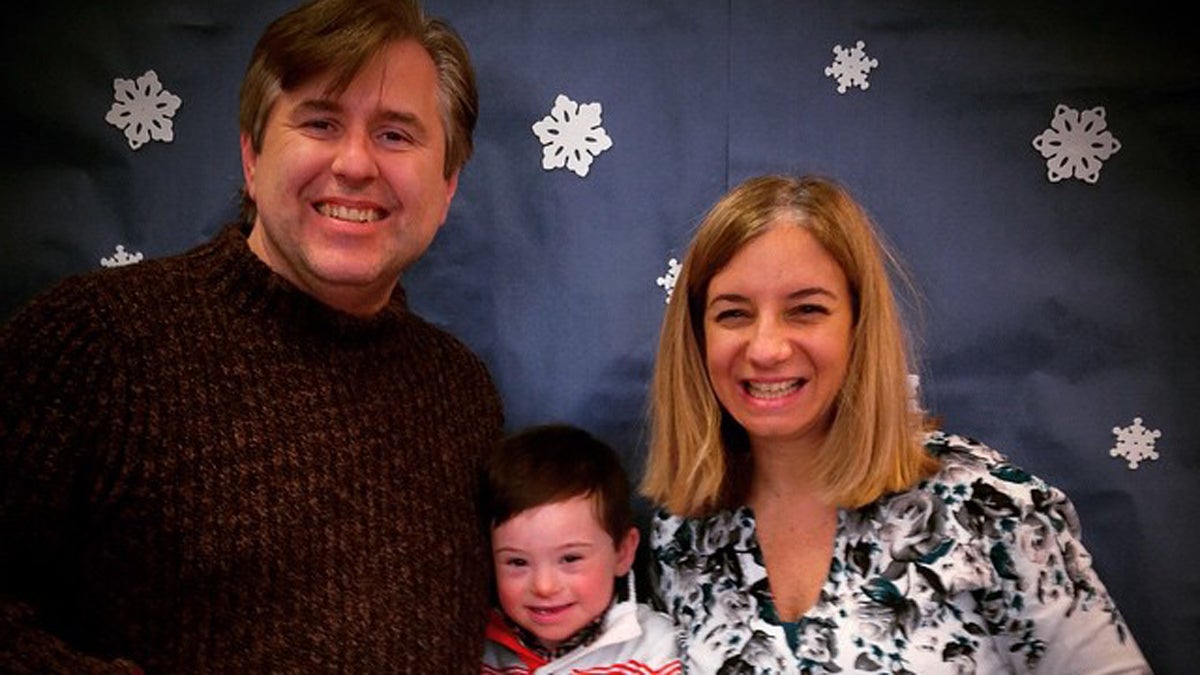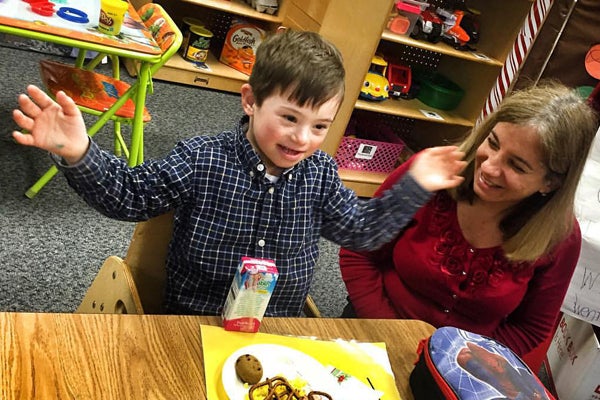Measuring the impact of prenatal genetic testing on Down Syndrome population
Listen
Tim and Candice Ogline, with their son, Philip. (Courtesy of the Oglines)
The thin woman wearing a big winter coat seems nervous, even though today, the news has been good.
“I went to my first prenatal appointment with the ObGyn this morning. Everything was fine,” she tells me. “They actually saw a heartbeat at six weeks, which they didn’t know if they were going to be able to do, so that was very exciting.”
I can hear the apprehension in her voice. She doesn’t want me to use her name, because nobody other than her husband – and now I – knows she’s pregnant yet. The apprehension is about everything that could go wrong, that she could yet find out.
“My inclination now as far as genetic testing, I am very much a ‘I need-to-knower.’ The idea of having less uncertainty is preferable to me.”
During her pregnancy with her first child, she didn’t do any of those tests, but she’s older now.
“As soon as you hit that 35 mark, it’s just there,” she says.
“It,” generally speaking, means a higher risk for genetic problems in the fetus – but what expectant parents seem most concerned about and want to test for is Down Syndrome – the most common genetic disorder in the United States – one in 792 babies are born with it.
And these days, expecting parents can choose from a variety of tests that will detect it early on in the pregnancy.
“It’s made it more complicated, it’s made it more technologic,” veteran ObGyn Stewart Weiner of Jefferson University Hospital in Philadelphia said about genetic testing. “But it’s settled into a place where it is empowering the pregnant woman by giving her information and knowledge.”
The information tests provide opens doors, sheds light – but it brings with it a lot of worrying, uncertainty, and tough choices.
“Prior to prenatal testing – Down Syndrome was a surprise postnatal diagnosis, and certainly the features are easily recognizable at birth most of the time,” said Brian Skotko, who co-directs the Down Syndrome program at Massachusetts General Hospital in Boston.
“Now, Down Syndrome is really shifting from a postnatal diagnosis to a prenatal one.”
New tests bring certainty early on
French physician Jérôme Lejeune identified Down Syndrome as a chromosomal condition in 1959 – where chromosome 21 is triplicated – rather than duplicated. Amniocentesis became widely used to test for Down Syndrome in the 1970s, another invasive test called Chorionic Villus Sampling started to be used in the 80s. During this time period, healthcare providers also started looking for markers of Down Syndrome during ultrasounds. For example, they measure the length of bones including the femur or nasal bones and look for abnormalities.
Five years ago, prenatal testing took a massive leap forward.
“Pregnancy as we know it changed in October of 2011 here in the U.S., and that’s when the cell-free DNA non-invasive prenatal screening test was introduced,” said Brian Skotko.
This is a simple blood test for the expectant woman, often abbreviated as NIPS. It analyzes tiny fragments of DNA from the placenta representing the fetus floating in the mother’s blood – and can detect if there is an extra copy of chromosome 21.
These tests can be done as early as nine weeks into the pregnancy – and are highly accurate.If a woman gets a positive result, she is encouraged to still complete a more invasive test before making any further decisions.
“Each year in the U.S., only about two percent of expecting women pursue Amniocentesis or Chorionic Villus Sampling, which are the only two tests which can confirm Down Syndrome diagnostically,” said Skotko.
And if that test comes back positive, Skotko says many couples feel like they’ve been punched in the stomach.
The vision of the future is suddenly changed. A serious, lifelong illness is now in the picture. Intellectual disability means the child will likely need care, help and support their entire lives. Often, Down Syndrome is accompanied by health conditions such as heart disease. What to do often becomes an overwhelming question of emotional and financial resources — a pressure cooker of uncertainties.
“Of those who get a positive result, research shows about 74 percent of them will choose to terminate their pregnancy,” Skotko explained.
In real numbers – says Skotko – that 74 percent after definitive positive tests – translates to about 3,100 Down Syndrome-related abortions each year.
About 5,300 babies with Down Syndrome are born annually – many women decide to forgo further testing, and many still find out after birth.
Skotko just completed a massive study of these numbers with his colleagues – and he expects that the effect of prenatal screening on this population will only increase, as tests become available earlier on in the pregnancy.
Moved onto a different track
Despite the many potentially scary, high-tech aspects of pregnancy – for many expecting parents this is still a time of true joy.
“We were so excited we were pregnant; we were so excited,” recalled Candice Ogline. “We told our parents on Mother’s Day; it was wonderful,” her husband, Tim, chimed in.
Candice and Tim Ogline live in Marlton, New Jersey. She’s a nurse practitioner, he’s a graphic designer. They had suffered a miscarriage early on in their marriage, and were thrilled to be expecting again.
They made plans and talked names.
“If it was a girl, she would name her, and if it was a boy I would name him,” said Tim Ogline. “I wanted a name that would look good on a book jacket when he was a famous writer one day.”
Since Candice was 40 years old at the time, her physician suggested some genetic testing. The test showed an elevated risk for Down Syndrome, and the genetic counselor said she could consider amniocentesis. Candice declined.
“Reason being is that if we got those results, we weren’t going to do anything anyway,” she explained.
Throughout the pregnancy, the Oglines stayed positive. An ultrasound had also shown that the baby had an enlarged kidney, so they were more concerned about that. That issue later resolved.
When their son Philip was born, they were told he had features of Down Syndrome and needed to undergo genetic testing. Candice did not believe it at first. In the hours and days after his birth, she told herself Philip was squinting. That his face was swollen from birth. Then she looked at Philip’s newborn pictures, taken at the hospital.
“And when I saw the picture, I can see the Down Syndrome features in the picture, and I just start crying, and I’m crying, and I’m all upset, even though we didn’t get the blood test yet.”
Three days later, her doctor called her up with the definitive diagnosis. Philip had down syndrome.
“I just couldn’t even talk, and he said ‘Candy, are you okay?’ And I said ‘I am not okay. I am not okay.'”
The Oglines went to see their priest to talk about the grief they felt – over the loss of the child they thought they would have. The priest talked to them about expectations – and asked them to re-think what happiness meant to them. Could they be happy if Philip was happy?
Both say it was a simple question that helped reframe their outlook.

Candice Ogline with her son, Philip. (Courtesy of the Oglines)
A new take on happiness
Philip is five years old now – and the Oglines can’t think of their life without him.
“He is an amazing little boy. We can’t imagine him being different. Or not having him around. He is a wonderful little kid. And we just love him!” said Tim Ogline.
Like pretty much every kid his age, Philip loves his parents’ smartphones, and knows how to take pictures. “Mommy, cheese,” he said as he snapped his mom’s photo. He has a mop of brown hair, a sweet smile and calls his dad Tim. He asks for things – Elmo, or yogurt, but at times, it’s hard to understand him.
“Speech-wise, he is delayed, even though he is five years old, developmentally he is two and a half,” said Candice. He’s receiving speech therapy, and goes part time to a regular preschool, and part time to one for kids with special needs.
They say that Philip doesn’t just bring joy to their lives – he makes people smile everywhere they go.
Brian Skotko has researched how Down Syndrome affects families, and also interviewed people living with the disorder for his studies.
“99 percent of people with Down Syndrome are happy with their lives, and 99 percent said they like how they look. When you interview the typical Americans, only 45 percent of us are happy with our lives,” he explained.
A disappearing population?
Skotko has a sister with Down Syndrome, and has met hundreds of patients living with this condition. He says a lot of the health conditions that tend to accompany Down Syndrome in addition to intellectual disability – such as heart or thyroid disease can be fixed today – and life expectancy for people with Down Syndrome has shot up to 50 – 60 years.
“There are probably around 200,000 Americans with Down Syndrome in the U.S. and it really comes down to two numbers: the longevity of people with Down Syndrome alive, and the number of new babies born with Down Syndrome,” he said. “Since people with Down Syndrome are living longer, we don’t know what impact that will have on the competing number of increasing terminations.”
Skotko says he will keep tracking that number.
Several states, including Pennsylvania, Delaware and Ohio have enacted Down Syndrome information acts – where parents have to be given additional information – often in the form of a pamphlet – on what it means to live with the condition when they receive a prenatal diagnosis.
Some states are considering – somewhat symbolic – bills that would outlaw abortions when the only reason for seeing termination is Down Syndrome.
Skotko feels that Down Syndrome is the “canary in the coal mine” a peek at how humans will respond and cope as more and more genetic conditions can be tested for.
Jefferson ObGyn Stewart Weiner shares this concern.
“It’s quite clear that in the not-too-distant future, we will have the ability to do a complete genome sequence on the unborn fetus – with just a blood test from the mother,” he said.
Early tests will be able to determine the gender of the fetus, or even test for genes related to breast cancer.
Weiner says these emerging options are already creating a lot of ethical discussions, because people are finding out more information than they know what to do with.
WHYY is your source for fact-based, in-depth journalism and information. As a nonprofit organization, we rely on financial support from readers like you. Please give today.




